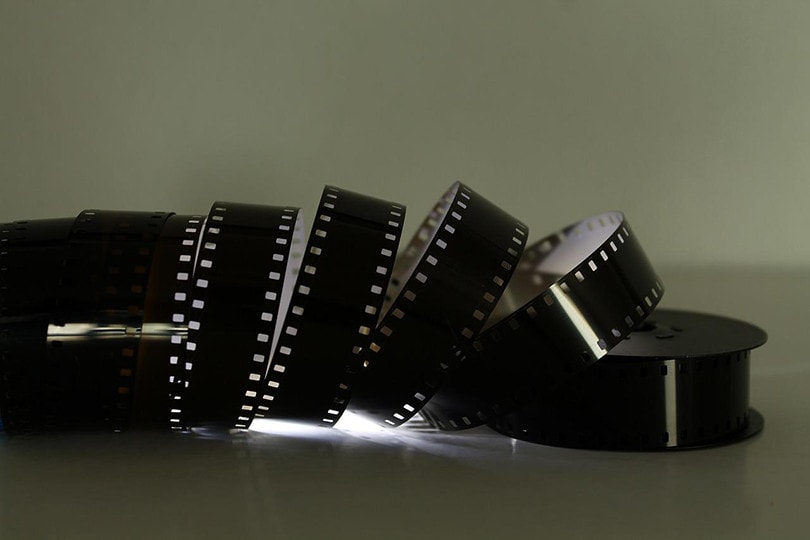How to View 8mm Film Without a Projector
Last Updated on

When you’re going through the old things of family members, a common occurrence is finding old 8mm film. If you’re lucky, there will also be a projector around to view it.
But what if you’re not that lucky? Is there any other way to see what’s on the film and view it? Fortunately, the answer is yes, and it’s easier than you might think.
You can look at everything with a bit of light and a magnifying glass, or you can digitize it for an easy viewing experience. We highlight everything that you need to know here, you’ll be viewing your 8mm film in no time!

How to View 8mm Film Without a Projector

There are a few different ways to figure out what’s on 8mm film.
Magnifying Glass and Light
If you’re just trying to figure out what’s on the film and don’t want to pay for anything or get any special equipment, all you need are a light source and a magnifying glass. 8mm film is nothing but a series of photos, so if you can see the film, you can see what’s on there!
Hold the film up to a window or another light source, and use a magnifying glass to get a better view of the film itself. It won’t play like a video, but you’ll be able to see everything that’s on there.
Digitize It!
If you don’t have a projector and simply want to view your 8mm film like you watch everything else, go ahead and digitize it! If you’re looking to do it yourself, the easiest way is with a projector, but there are plenty of stores like CVS, Costco, and Walgreens that will do it for you.
Just bring the film to one of these places, and it will digitize it for you so you can watch it on a traditional DVD player or even through a flash drive.
Get a Vintage Film Editor
Traditional film players use a large projector, but another option that you have is a vintage film editor. They work like a traditional film player, except you have to manually crank the film through.
It plays the video for you at the speed that you’re cranking, giving you full control of the show!

What Is the Best Way to Convert 8mm Film to Digital?
If you’re trying to convert 8mm film to a digital format, there are two different ways that you can do it. The easiest is to simply project the 8mm film and record it. However, that won’t give you the best quality, and if you don’t have a projector, it’s not an option.
The other choice that you have is to invest in an 8mm film to digital converter. However, while these devices do a great job of converting film, they are a bit expensive. So, unless you plan on converting multiple films, it’s probably best to take your film to a photo place and have the staff there convert it for you.

Where Can You Take 8mm Film to Transfer It to Digital?
If you’re not looking to invest in an 8mm film-to-digital converter, the good news is that many stores will convert your film for you. CVS, Costco, Walgreens, and even Wal-Mart are all options with many locations.
If you’re only converting a few 8mm films to a digital format, having one of these companies do it for you is probably the most cost-effective option that you have.
How Can I Watch My 8mm Videos Without the Video Camera?
Unless you can find a vintage product to view your film, it’s probably in your best interest to go ahead and convert the film to a digital format.
In fact, viewing 8mm film through a traditional projector can scratch and damage the film, so it’s best to convert it as soon as possible, even if you do want to keep viewing it that way.
Converting it sooner ensures that you get the best digital copy possible in case anything happens to the physical film while you’re viewing it.

Final Thoughts
Finding an old reel of 8mm film is exciting, but the real excitement is finding out what’s on there! Now you know that you don’t need to invest in an old-school projector if you want to watch the film. You can see what’s on there with nothing more than a magnifying glass and light, and you can then decide if you want to invest in converting it to a digital format!
Featured Image Credit: 15299, Pixabay
About the Author Robert Sparks
Robert’s obsession with all things optical started early in life, when his optician father would bring home prototypes for Robert to play with. Nowadays, Robert is dedicated to helping others find the right optics for their needs. His hobbies include astronomy, astrophysics, and model building. Originally from Newark, NJ, he resides in Santa Fe, New Mexico, where the nighttime skies are filled with glittering stars.
Related Articles:
How to Clean a Refractor Telescope: Step-by-Step Guide
How to Clean a Telescope Eyepiece: Step-by-Step Guide
How to Clean a Rifle Scope: 8 Expert Tips
Monocular vs Telescope: Differences Explained (With Pictures)
What Is a Monocular Used For? 8 Common Functions
How to Clean a Telescope Mirror: 8 Expert Tips
Brightfield vs Phase Contrast Microscopy: The Differences Explained
SkyCamHD Drone Review: Pros, Cons, FAQ, & Verdict
